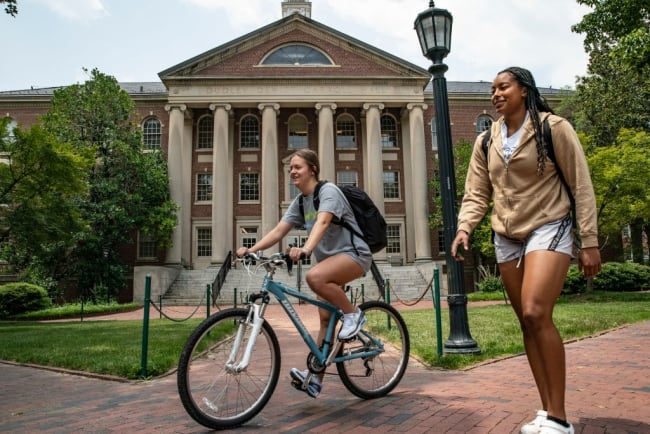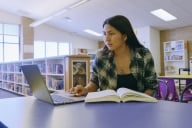You have /5 articles left.
Sign up for a free account or log in.

The University of North Carolina at Chapel Hill hired a director of financial well-being to support students navigating their personal finances and paying for college.
Eros Hoagland/Getty Images North America
Personal finances are one of the top concerns of college students across the nation, as learners grapple with the high costs of postsecondary education and elevated costs of living.

Gilbert Rogers, director of financial well-being at the University of North Carolina
University of North Carolina
At the University of North Carolina at Chapel Hill, Gilbert Rogers is the inaugural director of financial well-being, supporting a university vision to help students manage their money and help ease some of the daily stressors of finances.
Rogers spoke with Inside Higher Ed about his new role, how he works to promote student success and practical applications of financial literacy on his campus.
Q: What led you to a career in higher education?
A: My interest in a career in higher ed started out while I was an undergraduate student. I was a finance major and I knew I wanted to do something finance-related. However, as I was going through my classes, I felt as though, for some reason, I was behind. And it wasn’t because [of] learning or any sort of issue in that area, it was more so because I hadn’t been exposed to any of those areas, those personal finance areas were all new to me.
As I would spend hours in the library at nights playing catch up, I said that, “Once I grasp this knowledge, and once I gain it, I’m gonna be sure to pay it forward” and share it with others. And share it in a way in which I wouldn’t have to go through the rigor of learning all the terminology and things of that nature.
I would say that was the start, that’s where the spark began. And then it began to blossom and build as I identified new opportunities and more ways to educate, and eventually led me to UNC.
Q: What is your role and what are some of your responsibilities?
A: My new role is the director of financial well-being. And UNC has a unique approach where we’re approaching financial well-being from two different angles.
One is a financial education lens, where we are trying to educate students on the fundamentals of personal finance. And then the other lens is we’re trying to ensure that students’ basic needs are met. We’re trying to identify resources, identify opportunities to support students, so that they can focus on their education, as opposed to where that next healthy meal is going to come from, or how they’re going to pay that rent or something like that. We’re truly taking a holistic approach to serving students and I really appreciate that.
I think Carolina is truly investing in the success of students, and by creating a financial well-being program and really pushing this initiative forward, we’re truly an institution for all, and we’re making sure that we are contributing to the success of students.
Q: How would you define financial wellness? How does that tie into the institutional vision of student success?
A: I always use financial literacy to get the foundational area, but a financial literacy is the ability of individuals to both understand and apply basic financial concepts to real world financial situations.
Now, when it comes to well-being or a state of that, you have to, one, understand where the challenges are, as it relates to personal finance, learn what you can do to overcome those challenges. And then we provide that support. That’s when I think students reach a level of financial well-being.
Student success … I think it’s tied to ensuring that students can progress academically and eliminate some of the distractions that a university can actually control.
Life is going to happen to us all; along that college journey, things will happen. However, we can provide support and help students along the way, and we’re contributing to their success. So when it comes to eliminating some of the financial barriers that impact or impede students’ progress, then we’re contributing to the overall success of students. When we’re educating them on how to make smart decisions related to money while they’re in college, we’re, one, decreasing that level of stress or anxiety they may have, and then we’re also preparing them for what’s next when they graduate and being prepared to manage and take on different opportunities as they relate to money.
Q: Where do you see students’ learning gaps when it comes to financial wellness and literacy? What are some of the practical applications for students?
A: Students have access to so much technology and so much out there in the world of social media, that, some messages are actually factually based, others may not be.
It can become confusing when you’re getting so much info from so many different places. It can be information overload. So dialing things back, taking a step back and offering students fundamental personal finance–related topics that apply to where college students are. I think that’s how we would make a difference and ensure that students receive timely and relevant info.
A couple of areas I have identified: I think students don’t understand the importance of budgeting. And it’s because of not realizing that that’s the way in which you maximize your situation. Regardless of how much money you have, you need to have some sort of plan in place and have some sort of plan on how you’re going to work toward whatever your stated goal is.
That will require or enable you to say “no” to many situations, many of the extracurriculars that students may take part in, like going to the movies three or four times, or video games or whatever students do.
But … once you can say no to those opportunities because you have a goal in mind of what you want to reach as far as money, then you’re in a good spot. And what that does is, it builds solid habits that will carry on as you make more and more money post-graduation.
Another area that students are finding themselves in trouble: they’re wanting to invest early on instead of trying to take the steps to build up to that point. And when you do that with minimal knowledge, you can get into some bad situations. You may hear a stock tip on social media or something like that and go with it and then that can be a detrimental situation. My hope is that students avoid those situations.
Also, of course, we have students who are graduating with student loan debt. What we’re doing—Carolina is ensuring that they’re prepared. One, they understand how much they owe, and two, they establish a game plan for how they’re going to adjust that debt. That’s how you decrease the stress: Allow students to focus on their academic progress and feel comfortable once they graduate.
Q: There can be a lot of anxiety for students to talk about money. How do you make financial wellness approachable and easier for students?
A: There’s a couple of different things you do. What we’re going to build here at Carolina is … a peer financial coaching model where I will hire students. I will train students on personal finance–related topics. I will also be sure to hire students from all different backgrounds, all different socioeconomic backgrounds, different majors, so that we have a team that reflects campus.
Once we get those students in place, they will be trained to help students from all across campus [so] students won’t feel intimidated. Because if I’m a history major, and I come in, I see “Ashley, oh, you’re a history major too.” We can relate, we can connect, and then we can have a conversation doesn’t feel necessarily awkward.
We will have interactive workshops throughout each term where students can come and work with our center and learn these personal finance topics.
Another thing we’re doing is we’re taking financial literacy to students, and we’re partnering with different clubs and organizations across campus, that way we can meet students where they are, instead of waiting for them to come to us.
If you’re part of fraternity and sorority life, we’re going to the organizations and saying, “Hey, we want to facilitate, we want to provide this education.”
I just got out of a meeting with a colleague from the School of Pharmacy, and we’re going to create a tailored program for our pharmacy students, where we can adjust to their rigorous schedule, and provide that timely education so that they can come, they can attend and not worry about missing class or studying for a test.
So that’s how I envision meeting students where they are, tailoring that education to them, working around their schedule, understanding that there are other obligations, and they are a student first, but this is something that can help them propel to what’s next.
Q: What are your goals in your first year?
A: The first goal is just to increase awareness.
We’re currently planning a financial literacy symposium, which is actually this evening, and registration capped out, they maxed [it] out in the second day. A cap of 100 students, and that was full by day two, and we have over 100 students on the waitlist. So there’s interest there, what we have to now do is create awareness so that students know where the financial education opportunities are, and how they can get plugged in.
The second part of that is building out this peer-to-peer component, where we hire students from different backgrounds, we train them, and then they help become the ambassadors across campus for financial education, where they can spread the word. So early on, it’s building my staff out, I’ve got some hiring to do, as well as hiring peer coaches. And then once we’re in place, we’re gonna hit the ground running and really get across campus.
Tell us about an interactive format your institution is using to teach financial literacy to students. Share here.



